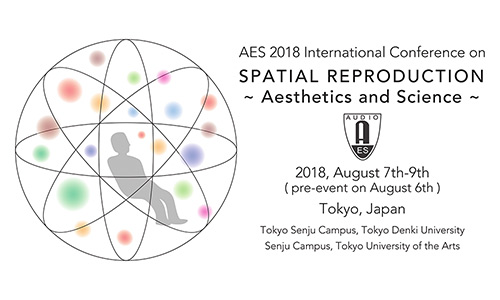
CD-607 Mixing studio for 22.2 Multi-channel Audio, NHK Broadcasting Center (Shibuya, Tokyo, Japan)
Capacity: 15 people (Preregistration is required preregistration closed thanks to the overwhelming interests!)
Japanese Traditional Music
No registration required. Please join us at Studio A, Senju Campus, Tokyo University of the Arts.
Special demonstration of a living room with 8K Super Hi-Vision and its 22.2 multichannel sound will be presented. No registration required. Please drop in at the entrance of Senju Campus, Tokyo University of the Arts.
NHK will begin satellite broadcasting of 4K/8K Super Hi-Vision in December, 2018. We are also engaged in initiatives to widely promote its adoption for home viewing by 2020. This exhibit will let you experience to watch Super Hi-Vision programs in a living room in the home.
Registration starts from 8:20 at the registration desk on 1st floor of TDU Building No.1
Welcome address “Future of IoT Era” by Hiroshi Yasuda (President, Tokyo Denki University)
With the accelerating evolution and growth of “IoT; Internet of Things” in recent years, societies and industries in the world are advancing faster than our expectation. However, at the same time, we are suffered by increasing cyber attacks. The talk first describes the progress of IoT, then today's situation of cyber security technologies. As IoT system is consisted of various elements, multi-disciplinary cyber security technology is needed. The talk then explains key technologies of multi-disciplinary cyber security, and also future prospect of IoT era.
Who has Wow?
What is Wow? When can I get Wow?
Where is Wow? Why is Wow needed? How can I get Wow?
Over one hundred years ago, audiences experienced “Wow” listening to a singer and comparing the sound with a recording. Observers found that it was “almost impossible to tell the difference” between what was live sound and what was recorded. Sixty years ago, the transition from monaural sound to stereophonic brought ‘realism’ into listener's homes and today audiences can be immersed in sound. This talk will trace a history of how listeners have been educated and entertained to the latest sonic developments and said to themselves and each other: “Wow!”
Special demonstration of a living room with 8K Super Hi-Vision and its 22.2 multichannel sound will be presented. No registration required. Please drop in at the entrance of Senju Campus, Tokyo University of the Arts.
Recent multichannel audio can capture the sound field with higher sense of reality. Since the audio format includes the detailed spatial information about the sound field in the production, the same loudspeaker arrangement with the production may be unnecessary in the reproduction. Instead of setting up such loudspeakers, audio rendering is required in the reproduction.
Many studies have been made on the audio rendering. They can handle the direct sound, because these methods were based on the directional information of channels. What seems to be lacking, however, is the rendering method of diffuse sound. In this presentation, we introduce the audio rendering method based on the decomposition of audio signal into direct and diffuse components, and clarify the requirements for the rendering of diffuse sound from the viewpoint of sound reflection in the room.
“HH:MM–” denotes that it starts every hour at minute MM. (for example, HH:12 starts at 14:12, 15:12, 16:12, and 17:12)
An example of Upmix form 2 channel stereo to 22.2 multichannel, and downmix from 22.2 to 2 channel stereo.
Special demonstration of a living room with 8K Super Hi-Vision and its 22.2 multichannel sound will be presented. No registration required. Please drop in at the entrance of Senju Campus, Tokyo University of the Arts.
The banquet fee is included in the conference registration fee.
“HH:MM–” denotes that it starts every hour at minute MM. (for example, HH:12 starts at 14:12, 15:12, and 16:12)
An example of Upmix form 2 channel stereo to 22.2 multichannel, and downmix from 22.2 to 2 channel stereo.
Special demonstration of a living room with 8K Super Hi-Vision and its 22.2 multichannel sound will be presented. No registration required. Please drop in at the entrance of Senju Campus, Tokyo University of the Arts.